|
Home > Chimpanzees > Biology
•Biology
of the common chimpanzee
The
common chimpanzee is a great monkey species living in tropical africa,
omnivorous with frugivorous predominance, largely arboricolous and diurnal.
Classification
ø
The great monkey is genetically nearest to the man with more than 98
% of the genetic inheritance common to both species.
With the gorillas, the chimpanzees are the only representatives of the great
monkeys on the African continent. They are classified in the order of the primates,
family of and Pan gene. We distinguishe two species from them:
· the common chimpanzee (Pan troglodytes),
main species of the H.E.L.P.
project
· the pygmé chimpanzee or bonobo
(Pan paniscus), this last livee only in the democratic Republic
of Congo, ex Zaire.
Among the common chimpanzees, we can distinguish four subspecies, and
this, due mainly to their geographical separation: Pyear T troglodytes
which is in central Africa and in particular in the Republic
of Congo, Pan T schweinfurthi in East Africa, Pan T verus
in West Africa and Pan T vellerosus or chimpanzee of Nigeria-Cameuroun.
Morphology
ø
the body of the chimpanzee is adapted
perfectly to climb and balanced itself to trees. The chimpanzees have
long disproportionate arms (in comparison with the mankind) facilitating the
access to the branches. They have hands and feet very flexible and prehensible,
enabling them to catch up itself easily. Thanks to their skill, they can
pass from branch to branch without those breaking under their weight. The
fingers are reduced, curved and have nails. Hands and feet are prehensible.
ø
Like the mankind, they do not have a tail
and hairs on the face, the plant of the feet, and the palm of
the hands. The common chimpanzees have powerful molars and the males also have
large canines. Upright, the males can reach from 1 to 1 meter 70, the females
being smaller.
ø Theur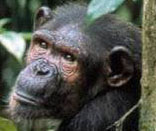 peeling is in theory black, rather sparse, but longor, color and distribution
on the body vary with the age, the subspecies and the individual. The young
individuals have the black hairs, the face rosâtre and a toupillon of
white hairs at the back, which disappears as the end of their first years. With
the age, the face gets more obscure, the color of the hairs can be cleared
up,the hairs become rarer on the face and the head.
peeling is in theory black, rather sparse, but longor, color and distribution
on the body vary with the age, the subspecies and the individual. The young
individuals have the black hairs, the face rosâtre and a toupillon of
white hairs at the back, which disappears as the end of their first years. With
the age, the face gets more obscure, the color of the hairs can be cleared
up,the hairs become rarer on the face and the head.
ø Some differences are to be noted according to the
subspecies considered. For example:
· The Eastern common chimpanzee
(Side T schweinfurthi) has a longer peeling than its subspecies and the
color of the face goes from bronze to coppered. Its weight can reach 43
kg for the males and 33 kg for the females.
· The common chimpanzee of central
Africa (Side T troglodytes) raises a black facial pigmentation, especially
with the age. Its weight can reach 60 kg for the males and 47 kg for the females.
It is the most massive subspecies.
· As for the Western common chimpanzee
(Side T verus), it has a rather pink color of skin which becomes darker
with the age. Peeling is black but can go from brown to hazel nut.
Distribution and habitat
ø
Distribution,
covering 21 country :
· The Eastern common chimpanzee : Democratic
republic of Congo, Uganda, Tanzania, Burundi, Rwanda, Sudan and Central African
Republic (RCA);
· The common chimpanzee of central Africa :
Cameroun, Gabon, Republic of Congo, equatorial Guinea, RCA and Angola;
· The Western common chimpanzee : Guinea,
Côte.d'ivoire, Mali, Liberia, Guinea-Bissau, Sierra Leone, Senegal and
Ghana ;
· The fourth subspecies is in Nigeria
and Cameroun.
ø the
habitat varies to wet dense forests, where live the densest populations,
to the dry forests and raised savannas, while passing by the marshy forests
or of mountain (up to 2800 m of altitude).
Locomotion 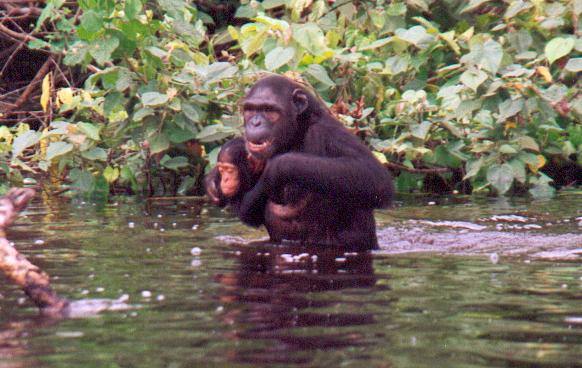
ø
the chimpanzees
move on the ground in a quadruped way, in a their very own position (like with
the gorillas) which is called "knuckle-walking". It is a type of quadruped walk
based on the fact that the weight of the higher part of the body is supported
by the dorsal surface of the second phalanges of the fingers of the hand.
In the trees, this species can also move in a quadruped manner.
ø On
the ground, the chimpanzees can adopt a biped walk. But that comes mainly during
the demonstrations of predominance, the displays or to cross on the ground some
obstacles like mud or water zones, not very wide.
ø the
chimpanzees cannot swim and certain populations are afraid of water,
especially if this element is not very present in their environment.
Ecology and food behavior
ø
 In
general, the chimpanzees pass almost half of their time feeding themselves
(on average 47 %) and a good part of the time remaining (13 %) is dedicated
to move from a fedding place to another. Most of the time passed to feed themselves
takes place mainly in height, in the trees, and this up to 88 % in rain season.
There are two peaks of food spread out over one day: one in the morning between
7h and 9h and one in the afternoon between 15h30 and nightfall. In
general, the chimpanzees pass almost half of their time feeding themselves
(on average 47 %) and a good part of the time remaining (13 %) is dedicated
to move from a fedding place to another. Most of the time passed to feed themselves
takes place mainly in height, in the trees, and this up to 88 % in rain season.
There are two peaks of food spread out over one day: one in the morning between
7h and 9h and one in the afternoon between 15h30 and nightfall.
ø Food
diversity with the chimpanzees is remarkable; they consume seeds, nut, fruits,
flowers, sheets, stems, sap, bark, honey, insects (ants, termites), as well
as the vertebrate ones (in particular monkeys). The common chimpanzee can
introduce 300 different species of plants in one year and approximately
20 different species per day.
ø  It
was shown that the participation of the fruits in their food represents
approximately 48 %. The share of the sheets and buds represents 25 %. The 27
% remaining include a mixture of seeds, flowers, stems, sap, etc... During the
dry season, when the fruits become rare, food like the flowers, the barks,
the stems become important food resources. It
was shown that the participation of the fruits in their food represents
approximately 48 %. The share of the sheets and buds represents 25 %. The 27
% remaining include a mixture of seeds, flowers, stems, sap, etc... During the
dry season, when the fruits become rare, food like the flowers, the barks,
the stems become important food resources.
ø The
chimpanzees can enrich their food with stone, soil and clay ingestion
found on the level of ant-hill, and this for a mineral contribution. It was
observed that it is on the one hand the very fine consistency of material and,
on the other hand the richness of this one out of sodium chloride which encourage
the animals to introduce the "saltworks" created by the termites themselves.
ø The
observation of coprophage
behavior in the chimpanzees raises various questions among the scientists.
For some, it acts of a mental or nutritional imbalance, related to food deficits,
fibres in insufficient quantity in the ration, the bordom or the stress. It
is increasingly allowed that the coprophagie can also be a physiological
adaptation allowing the maintenance in the digestive tract of ciliés
which digest cellulose or the assimilation of vitamins synthesized in the large
intestine but assimilable in the small intestine.
ø The
chimpanzees are omnivores able to hunt. In general, the males form hunting
groups. They can hunt wild pigs, antelopes (in general new born ones) and
especially monkeys. A species of monkey very often hunted is Procolobus
badius. The behavior of hunting shows strong variations according to the
populations of chimpanzees, some of them using this technique very often. The
hunting act can be divided into three phases:
· the chase which in general lasts only
a few seconds or minutes and covers a short distance;
· the capture which is a short event ending
in the beginning of the dismemberment of the prey;
· the consumption which is often accompanied
by important social exchanges: the individual having carried out successfully
slaughter, will eat the greatest part of the prey; the others will beg the remainders
which they will obtain in general. Very often, the meat consumption is associated
with sheets.
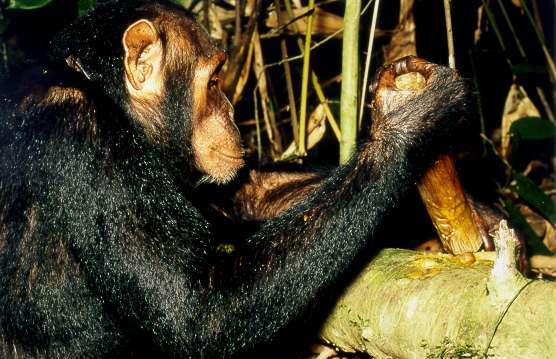 ø Another
technique of food is to be noted: the use of tools. Various examples
of use of tools by the chimpanzees were observed on several occasions, that
is to extract living insects from tree trunks or to open nuts.
ø Another
technique of food is to be noted: the use of tools. Various examples
of use of tools by the chimpanzees were observed on several occasions, that
is to extract living insects from tree trunks or to open nuts.
The Western common chimpanzee uses stones as hammer to break Palm nuts.
First of all they select a stonel then place the nut on another stone or in
the hollow of a large root of tree, this in order to immobilize it; finally
they hit the nut with the stone in order to break it. The individuals can use
the same stone in a repeated way. The nut species for which they use these tools
are Coula edulis and Panda oleosa. The subspecies of central Africa,
as for it, uses kinds of bludgeons out of wooden instead of stone as a hammer.
The subspecies of the East seeks the same nut species but does not break them
with tools, they feed themselves rather with the skin being on the surface.
That suggests a certain degree of differentiation among the subspecies, kind
of regional culture.
About the termites "fishing" , for example, the chimpanzees of central
Africa select brushwood which they insert inside the nest (in the shape of small
cliff); the termites, attacking any foreign body entering the nest, position
themselves on this same brushwood that the chimpanzee will extract and will
lick thereafter. The chimpanzees of the East adopt the same behavior but "to
fish" ants; there are thus local variations regarding the "fished" species.
Within a group, the youthful ones learn how to use the various tools by observing
their parents and while trying to imitate their mothers and elder.
ø
Some chimpanzees were observed eating in
certain cases plants known for their therapeutic vertue.
Are they good pharmacists and heal themselves this way?
Social structure and behaviors
ø
The social structure for the common chimpanzee is described as a society known
as "Fusion-Fission". At the base, there is a community, made up
of sub-groups varying in a number and composition, being linked "fusion" or
separating "fission", under the influence of various factors. A community includes
all the individuals who are regularly observed within the various temporary
sub-groups and this, over several months. This community can be described as
a "unit group" and its members share a common space of life, the surface of
distribution. The number of individuals within a community can vary from 20
to approximately 80.
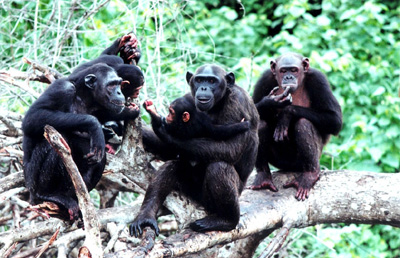 Living
in groups can bring three advantages: Living
in groups can bring three advantages:
· to decrease the pressure of predation
· to improve the exploitation and protection
of the food resources
· to make easier a social or co-operative
behavior, like the reproduction or hunting.
ø
Within a community of chimpanzees, we can
meet groups of different nature :
· only males
· adult females accompanied by their small
bisexual babies
· a female and its descent
· an individual alone
In general, the average size of each sub-group is lower than 10 and borders
five individuals rather. There is a great diversity in the constitution of these
sub-groups or groups. This great fluidity makes it possible to each individual
to have the advisability of joining to sub-groups of different sizes.
This diversity is observed for all the activities, whatever the nature and the
size of the group is.
It was observed that three principal factors intervene in the
variations of the size of the sub-groups:
· first of all the availability of
fruits which increases in rain season, which explains more important sub-groups
· sexual interactions: the females in
oestrus tend to come to inflate the number of individuals within the groups
· the period of hunting (mainly in rain
season) can also help to explain the important size of the groups during this
season
ø
The different communities have vital fields
which can overlap. Sometimes fights very violent can take place
between males of close communities, even often until causing very serious wounds
or causing the death of interacteurs. Indeed, the males represent the "core"
of a community and protect the members of their group. They spend their time
supervising, they patrol around the limits of their territory by excluding any
nonrelated candidate to the group.
ø
Fights from predominance can occur
between males of the same community because this one is based on a system of
hierarchy. The males are phylopatric, i.e. that they tend to remain in
the community where they were born. The more the males of the same community
get older, the more they join the other males and are integrated into the hierarchy.
Associations between males are strongest within the group and we often attends
with divisions of food or scenes of grooming between them. Within this structure,
the status "alpha", i.e. the status of the male having the highest placed in
the hierarchy, is often obtained thanks to a whole of coalitions established
with a brother or a nonrelated older male.
ø
Contrary to the males, the females rather
tend to move away from their habitat of birth, especially after having reached
maturity. Moreover, the nonrelated females but pertaining to the same group,
will not show many interactions between them.
ø
Child murder was also observed for
this species and occurs when an adult male keep silent the child of a not very
familiar female or when a doubt about the paternity of the child remains.
Ecology and space
of life
ø
Like many mammals, the chimpanzees are
sedentary and concentrate their activity on a limited surface, corresponding
to their vital field. This last is on average about 7 km² in this
species; the average daily distance traversed during displacements (most important
being done on the ground) is estimated at 3,90 km. In addition, it was often
observed that the males use a surface much larger than the females (1,5 to 2
times larger at Kibale).
ø
By analyzing the vital fields of the chimpanzees
of Gombe (Tanzania), it was shown that the individuals tended to occupy inside
the vital field of the community some zones more than others: we speak
about "center surfaces". The localization of these "center surfaces" remain
stable over a period of at least one year, but it appears that the size of those
varies in a seasonal way for the males. Moreover, the males are much more often
observed in limits of surfaces that the females. The females in heat, as for
them, see their space life increasing and use a surface more important
than the normal in order to meet males of their own community or even of close
communities.
Communication
ø
The way of communication between individuals, sub-groups or even different communities,
are very many and often rather complex. We can distinguish three types of communications
very much used by the chimpanzees:
· the visual communication
· the vocal communication
· the tactile communication
The olfactive communication is negligible for this species.
ø Visual
Communication
It occupies an important place in the society. The chimpanzees use many
postures or many very significant gestures, such as for example:
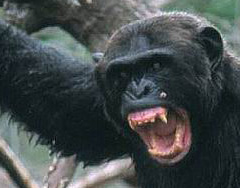 ·
Open mouth grin : the mouth is open, the commissures of the lips
are drawn backwards and the teeth are visible; this display is used when an
individual is threatened by another, higher placed in the hierarchy. ·
Open mouth grin : the mouth is open, the commissures of the lips
are drawn backwards and the teeth are visible; this display is used when an
individual is threatened by another, higher placed in the hierarchy.
· Open mouth threat : the mouth is open
but the teeth are covered by the lips and the eyes aim at a congeneric; this
display is used to frighten a subordinate.
· Tense-mouth face : the lips are firmly
compressed and the eyes aim at a congeneric; this display occurs as well before
or during hunting towards a subordinate as before or during the copulation.
· Play face : the eyes and the mouth
are open but the teeth are not visible; this display occurs during the play
with the other congeneric ones.
· Flapping : a slap is given to congeneric
with a movement applied downwards; this display takes place at the time of an
aggression between females.
· Social presenting : an individual adopts
a posture quadruped with the croup directed towards the face of the receiver.
This posture is carried out by the females towards the males or males subordinates
towards dominant males. It acts of a posture of tender which occurs after an
attack by the attacked individuals.
· Charging display : an individual runs
or launches stones, shakes objects such as branches, tambourine, slap the ground,
stamp one's feet and pushes cries. This reaction characterizes in particular
the adult males and occurs when dominating another individual meets after one
rather long period or when the male alpha wants to ensure itself of its predominance
towards its subordinates. Certain adult males carry out this demonstration at
the time of torrential rains.
ø
Vocal Communication
There are three principal cries or characteristic growls:
· Pant-hoot : that consists of a series
of noisy cries going up tone and often finishing themselves by howls. These
cries are often given by males but it happens that the females use them. These
cries resound when a site of food is discovered; it follows a regrouping of
individuals a few days afterwards. This cry can also occur at the time of a
"charging display".
· Pant-grunt : they are weak growls emitted
by subordinates towards the individual dominating in response to a demonstration
of predominance like a "charging display".
· Wraaa : this cry is emitted when the
animals are afraid, in particular of something strange and new for them.
ø
Tactile Communication
This type of communication between individuals takes a part quite as significant
as the preceding ones; we can distinguish:
· Reaching/touching : it is when an individual
touches with the hand, that is to say the head, the back or the croup of a congeneric.
It acts of a gesture of appeasing, of comfort in response to a " social presenting
".
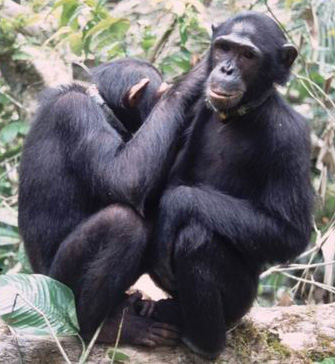 ·
Embracing : an individual surrounds a congeneric with one or two
arms, facing, on the side or of back. This gesture is often observed between
a mother and a frightened child. ·
Embracing : an individual surrounds a congeneric with one or two
arms, facing, on the side or of back. This gesture is often observed between
a mother and a frightened child.
· Submissive mounting : a subordinate
goes up dominating after being charged or being attacked and seizes the individual
with the size, and sometimes catches the testicles with his feet.
· Reassurance mounting : dominating a
subordinate in response to a "social presenting goes up ".
· Social grooming : an
individual removes the parasites and dead skins of another. This makes it possible
to maintain the bonds social and to reinforce them if needed. We frequently
observes this behavior between males and especially of a subordinate towards
dominating. In the common chimpanzee, that also occurs between members of the
same family
Reproduction 
ø
The common chimpanzee gives birth to
a young person in general; the twins are rare. Gestation can extend from 202
to 261 days, with a 230 days average. The llabor can take place during all the
year, the period of heat is approximately 35-36 days. During the oestrus (period
of heat), the périneum (surface including the external anus and genitals)
of the female is swollen.
ø
There is an interval of a minimum three
years between the births but five to six years of interval are more
frequent when the young person survives. A female can give birth once a year
if the baby is confiscated or killed at the time of the first months of his
life.
ø During
the first three months, the child is rocked by the mother when this one
takes a sitting position. Until he is six months old, the child clings to the
belly of his mother when this one moves then migrates on its back during the
years which follow. Weaning takes place between 3 years and a half and 4 years
and a half but the young baby can remain dependent of his mother during still
of many years and it is frequent that it remains with her until he is 10
years old or more.
ø Puberty
is reached at 7 years old for the two sexes and the females generally do
not give birth before to have reached 13 or 14 years. They can however come
into labor until she is 40 years old. The oldest females are more popular than
the young people who must often leave the community, either temporarily, or
definitively to go reproduce themselves.
ø The
males, as for them, are not integrated into the social structure before 15-16
years. At the time of the reproduction, the male requests the copulation by
showing its penis in erection and roughcasting its hairs. The majority of the
copulations are dorso-ventral.
|

